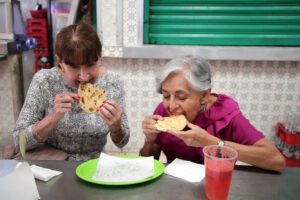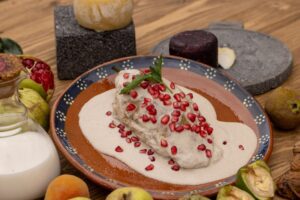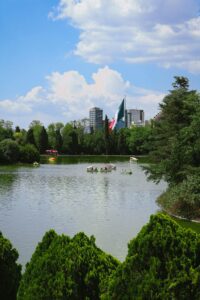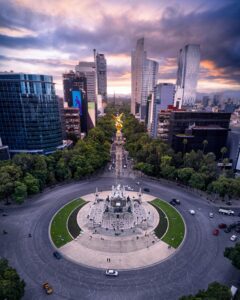MEXICO CITY
Mexico City is not only the capital of the country but also the capital Taco Capital of the World. It is one of the oldest cities in America, founded by the Indigenous Mexicas. It was originally built on an island in Lake Texcoco named Méxihco-Tenochtitlán.
Mexico City represents all of Mexico, to the point that even residents of the other 31 states of the Mexican Republic, when they visit the City, usually say that they are going to “Mexico” as if they live in a completely different place and are not already in Mexican Country.
Currently, the City covers a land area of 5,954 km², this includes the state now called “CDMX” (formerly known as the Federal District) with its 16 mayoralties, divided into 1812 neighborhoods within, plus 59 municipalities of the Estado de México and 1 municipality of Hidalgo.
Photo by Ricky Esquivel
On one of the Eating With Carmen Food Tours in Riviera Maya, I was asked what would be equivalent to Mexico City in the USA. The answer is that it does not exist, but let’s try to imagine it: take Washington DC as the capital where the Federal Government is located, but make it the size of Los Angeles, Dallas, and Houston together, and then add to that a concentration of almost 22 million inhabitants, and finish by calling it “America City”. Sounds crazy right? Well, such is the City where I grew up.
Touring and enjoying CDMX is a journey that can last up to three weeks or more, from discovering the peculiarities of each neighborhood to visiting more than 200 museums and art galleries while making a few stops to enjoy the most delicious traditional Mexican food is not an easy task as you might think. The distances from one place to another may seem relatively short. Still, the chaotic traffic that characterizes this city usually turns a 30-minute car or Uber trip into a trip of up to 3 hours. (No b.s.)

Many activities can be done on foot or by bicycle, but to get from the North to the South of the City, public transportation offers endless options, ranging from street taxis, more than 100 truck and public van routes, 12 subway lines, an electric suburban rail system, 12 trolleybus routes, 6 metro-bus lines, and up to 3 cable bus lines. That’s not counting the bike and motorcycle taxis that exist in certain mayoralties.
TIP FROM A RESPECTABLE CHILANGO: For no reason, use the subway between 8 am and 10 am or between 5 pm and 8 pm because they are peak hours unless you enjoy being underground with thousands of people who have no respect for personal space whatsoever.
Each of these means of transportation reaches every hidden corner of the City, but to make your trip to CDMX worth it, I think it’s a better idea to split your vacay and visit the different most iconic neighborhoods and stay a few days in each of them, to be able to appreciate them in more detail since each neighborhood is different from the other. More than anything, this way you won’t have to waste half of your time in traffic on the way to and from your hotel and thus immerse yourself in the magic of this City.
But… where to start? That’s why I bring you a special selection of four unmissable neighborhoods to visit in CDMX:
1. MEXICO CITY’S HISTORIC CENTER – DOWNTOWN
The Historic Center is where this vast country’s history begins. What was previously known as Mexico-Tenochtitlan was the seat of government of the Mexica Empire.
When walking through the streets of the Historic Center of Mexico City you are taking a trip to the past of the history of Mexico narrated in each of the buildings that surround it where you can see different architectural styles such as baroque, Renaissance, and neoclassical, that merge in perfect harmony.
Photo by Oscar Dominguez
PALACIO NACIONAL
During the conquest of the Spanish, Emperor Moctezuma’s palace was sacked and destroyed, and its remains were used to build, in that same place, what is now known as the National Palace from where once the Viceroyalty of New Spain was governed, and where The United Mexican States (That’s the official name of the country) are governed to this day. The National Palace is one of the many buildings surrounding the Zocalo at La Plaza de la Constitución. It is the home of the Executive branch, where many presidents have lived. It has a free museum inside where the long history of Mexico is narrated, decorated with Murals by Diego Rivera.
ALL-TIME MEXICAN FLAVORS
In Mexico’s downtown, you will find many buildings including houses, bookstores, museums, shops, old cantinas, and restaurants, some of which are more than 100 years old, such as the Ópera Bar from 1895. In the Historic Center, you can enjoy most of the traditional Mexican dishes, from the famous Chile en Nogada of the Hostería de Santo Domingo of 1860, or eat all kinds of delicious tacos and “garnachas” or snacks in the endless offer of street stalls decorating the streets.
Photo by Fernando Gomez Cortes
Join the Historic Center Local Experience Food Tour with Eating with Carmen, offering a delicious gastronomic tour through the old streets of the Historic Center, where you can delight your palate with the most authentic flavors and dishes of Mexican food seasoned with bites of history, guided by a local expert who knows the Historic Center inside out. Uncover the hidden gems and iconic sites that make this area a must-visit for food and history enthusiasts.
TEMPLO MAYOR
A visit to Mexico is not complete without visiting an archeological site of one of the many prehispanic cultures. In Mexico City’s downtown, you can find the Templo Mayor of Tenochtitlán, the center of the political and religious life of the Mexica society. It consisted of pyramids, monuments, and temples dedicated to Tláloc, the God of water, and Huitzilopochtli, the God of war. Currently, apart from touring the vestiges of the Templo Mayor, you can visit a museum that preserves thousands of holly pieces of the Mexica gods and goddesses, stone figures, and objects from ancient civilizations.
PALACIO DE BELLAS ARTES
Considered the most beautiful building in the city, for 86 years the Palace of Fine Arts has remained the iconic venue of culture in Mexico for the spaces dedicated to different artistic disciplines: theater, dance, opera, music, literature, and plastic arts, as well as for its architectural majesty. Its construction dates back to the end of Porfirio Díaz’s mandate, on the occasion of the celebration of the centenary of the beginning of Mexico’s Independence. The design was entrusted to the Italian architect Adamo Boari, who designed an eclectic building mixing Art Nouveau and Art Deco styles.
Photo by Rafael Guajardo
2. COYOACÁN
Coyoacán is a neighborhood located south of the City that existed long before the Mexicas founded Mexico-Tenochtitlan. In Coyoacan “place of the coyote owners” or “place of coyotes” traces of the first Mesoamerican cultures settled in the area were found as it was an important urban center made up of residential areas and a complex religious and ceremonial epicenter. Later, Coyoacán would be where Cortés decided to settle and govern the first phases of the Viceroyalty while the reconstruction of the extinct Mexica city was carried out.
POPULAR ATTRACTIONS
It is currently one of the most popular neighborhoods to visit in CDMX, being a site with a high concentration of cultural and tourist infrastructure, housing important areas such as the Pedregal de San Ángel Ecological Reserve and the University City of the National Autonomous University of Mexico (UNAM) declared in 2007 as a World Heritage Site.
Photo by Edgar Mosqueda Camacho
The square in the historic center of Coyoacán is mainly made up of two beautiful gardens, the Hidalgo Garden and the Centenario Garden, which adorn one of the most intellectual and bohemian neighborhoods of the Mexican capital where numerous national and foreign public figures, artists, intellectuals, and politicians, have had their residence giving rise to large venues such as the Frida Kahlo Museum, the Alfredo Guati Rojo National Watercolor Museum, the León Trotsky House Museum, the Automobile Museum, and the University Museum of Contemporary Art.
Soak in the authentic Mexican culture at one of my favorite places on Earth, La Cineteca Nacional, a space where you can see the best of national and international art cinema. To enjoy a bit of theatrical drama, visit La Capilla, a cultural forum that for more than 70 years has opened its doors to the best theater scene. And if that’s not enough entertainment, around the plaza you will always find mimes, clowns, and dancers adding more atmosphere to Coyoacan.
Photo by Jerome Moreno
AUTHENTIC FLAVOURS
Accompanied by centuries of Mexican culture and tradition, we can find the Coyoacan Market, showcasing all types of local crafts and recognized for the wide offer of the most delicious typical Mexican food. Enjoy a beautiful afternoon accompanied by local musicians giving life to the restaurants, cantinas, and all kinds of street stalls that serve everything from traditional roasted corn to delicious desserts such as gorditas de nata and ice creams of all flavors.
Explore the Vibrant Soul of this unique neighborhood through its flavors on the Coyoacán Local Experience Food Tour brought to you by Eating With Carmen Food Tours, where you will fill your soul and your stomach with the most delicious dishes and traditional snacks of Mexican food accompanied by a local foodie expert who will make you live a unique and delicious experience.

3. LA CONDESA AND LA ROMA
From among the most popular and busiest neighborhoods in CDMX in the Cuauhtémoc mayoralty. These two neighborhoods are the epicenter of the best nightlife in Mexico City, hosting a few of the World’s 50 Best Bars with the latest cocktails like Handshake Speakeasy or Wallace Whiskey Bar and many more Michelin-starred restaurants like Esquina Común and Rosetta, representing the most delicious of Mexican gastronomy.
Source: foodandpleasure.com
As you walk through the bohemian and ancient streets of La Condesa and La Roma, you will be able to taste exquisite architecture that ranges from eclectic styles, Art Deco, and even Californian colonial, appearing along the way facades with neo-medieval and neo-Gothic features. Home to a lot of art galleries, vintage clothing stores, tattoo shops, all this around one of the most beautiful urban parks like Parque Mexico where you can enjoy your afternoons with a quiet walk with your dog or take an ice cream at the famous Roxy ice cream shop.
To enjoy an authentic local experience, it is best to spend a few days staying in the surrounding area, either in an old residence or in one of the most modern hotels around.
4. CHAPULTEPEC AND REFORMA
Chapultepec and Reforma are surrounded by one of the largest city parks in Mexico, Chapultepec is essentially divided into 4 sections, with the Bosque de Chapultepec being the first section and the most visited part. The Chapultepec Forest is one of the best and largest nature reserves and recreational areas in Mexico City measuring in total just over 686 hectares, twice the size of New York’s Central Park.
Photo by Daniel Cruz
CHAPULTEPEC CASTLE
At the top of the Chapultepec forest, you can see El Castillo de Chapultepec, one of the best museums in the city built in the late colonial period. The palace was later occupied by Maximilian the 1st, of the House of Habsburg Lorraine, an Austrian archduke who became emperor of the Second Mexican Empire, and later served as the official residence of the Mexican presidents until 1940. After that, the leaders went to another part of the park called Los Pinos, which until 2018 was the main presidential residence.
The castle is one of the places with the best views of the city and is surrounded by monuments, fountains, and other interesting spaces, it is a place with as much history as the museum of which it is home. Its permanent collections include paintings, documents, technology, clothing, and furniture from different periods of Mexican history. Beginning with the fall of Tenochtitlán in 1521 until the Mexican Revolution, the museum also hosts conferences, concerts, and artistic events.
It remained empty during the war of independence and in 1833 it was assigned to the Military College. The castle is most famous for being the site of the Battle of Chapultepec during the Mexican-American War. In this battle, the cadets of the military school defended the castle to death on September 13, 1847, and are currently known as “The Boy-Heroes of Chapultepec” who are honored in the monument to the Niños Héroes within the same forest.
Photo by Daniel Cruz
In the Chapultepec Forest, you can find endless activities such as walking around Chapultepec Lake and rowing a boat, visiting the Botanical Garden, visiting the Papalote Children’s Museum, walking through the children’s areas, living with nature, and even cycling. or run on the Chapultepec Forest circuit route.
MEXICO CITY ZOO
It is considered one of the most visited zoos in the world, receiving more than 5.5 million visitors a year, including students from all over the country. The Chapultepec Zoo logo is the pre-Hispanic representation of a jaguar. Some of the most important native species at the Chapultepec Zoo are the Volcano rabbit, Mexican wolf, howler monkey, ocelot, jaguar, river otter, mountain parrot, ocellated turkey, Xochimilco axolotl, and the Red Knee Tarantula.
Photo by Ricky Esquivel
Exotic species include, among others, giant panda, red panda, lowland gorilla, Asian elephant, Grevy’s zebra, masked bear, Humboldt penguin, stone tuft, Andean condor, and Bornean argos pheasant.
The Chapultepec Zoo is involved with various conservation projects, especially in the captive reproduction of species such as the volcano rabbit, Mexican wolf, ocelot, giant panda, masked bear, bighorn sheep, and Xochimilco axolotl, through natural and artificial methods.
MUSEUM OF ANTHROPOLOGY
Inaugurated on September 17, 1964, and, for more than five decades, it has fulfilled the mission of researching, preserving, exhibiting, and disseminating the archaeological legacy of the peoples of Mesoamerica and the ethnic diversity of the country. This icon of 20th-century urban architecture was designed to be a space for reflection on the rich indigenous heritage of our multicultural nation. The 22 rooms and its more than 45 thousand square meters of construction make it the largest museum in Mexico and one of the most visited in the world.
Photo by Jesus Toledo
ANGEL DE LA INDEPENDENCIA
Officially known as the Independence Monument, it has guarded one of the 10 roundabouts on Paseo de la Reforma since the celebrations of the centenary of Mexican Independence in 1910.
The monument is built on several steps, surrounded by bronze sculptures at the bottom representing law, war, justice, and peace, it has a bronze statue of a giant lion with a child from Rivas Mercado, which symbolizes the Mexican town, the column is 36 meters (118 feet) high and inside, a staircase of 200 steps leads to a viewing point. Above it all is a 6.7-meter (22-foot), 7-ton statue of the Greek goddess of victory, Nike, designed and cast by French-Italian artist Enrique Alciati. The remains of the 14 heroes of the War of Independence are buried inside the monument.
Photo by Alex wolf mx
CDMX is a city so ginormous that few Mexicans have managed to get to know it from end to end. Each path brings you closer to places that you never imagined existed here, surprising us with the folklore and authenticity that the citizens provide.
A city full of history, beautiful architecture, green areas, and of course the best in traditional Mexican food.
Without a doubt, a must-see place on the list for those lovers of Mexican culture!
Until next time.
-Abbey, a proud Chilanga.


















